
A | B | C | D | E | F | G | H | CH | I | J | K | L | M | N | O | P | Q | R | S | T | U | V | W | X | Y | Z | 0 | 1 | 2 | 3 | 4 | 5 | 6 | 7 | 8 | 9
| Polish contribution to World War II | |
|---|---|
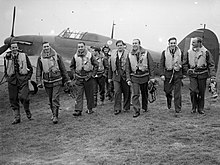 Pilots of the No. 303 Squadron, from left: P/O Ferić, Flt Lt Kent, F/O Grzeszczak, P/O Radomski, P/O Zumbach, P/O Łokuciewski, F/O Henneberg, Sgt. Rogowski, Sgt. Szaposznikow | |
 One of the four Polish Enigma doubles assembled eight years after Poland was first to crack the German machine, in 1932 | |
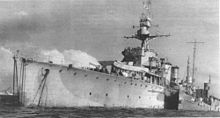 ORP Dragon, in Polish Navy service from January 1943 | |
 | |
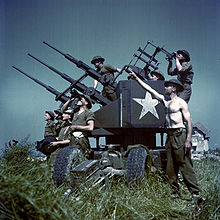 Anti-aircraft mounting with three Polish Polsten cannons | |
 Crew of submarine ORP Sokół with Jolly Roger marking number of sunk or damaged enemy ships | |
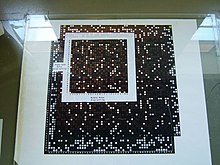 Demonstration of Zygalski sheets (perforated sheets) |
In World War II, the Polish armed forces were the fourth largest Allied forces in Europe, after those of the Soviet Union, United States, and Britain.[1][2][3][4][5][6][7] Poles made substantial contributions to the Allied effort throughout the war, fighting on land, sea, and in the air.
Polish forces in the east, fighting alongside the Red army and under Soviet high command, took part in the Soviet offensives across Belarus and Ukraine into Poland and across the Vistula and Oder Rivers to the Battle of Berlin.
In the west, Polish paratroopers from the 1st Independent Polish Parachute Brigade fought in the Battle of Arnhem / Operation Market Garden;[8] while ground troops were present in the North Africa Campaign (siege of Tobruk); the Italian campaign (including the capture of the monastery hill at the Battle of Monte Cassino); and in battles following the invasion of France (the battle of the Falaise pocket; and an armored division in the Western Allied invasion of Germany).
Particularly well-documented was the service of 145 Polish pilots flying British planes under British Command during the Battle of Britain, 79 in mixed squadrons under the RAF after July 1940, 32 in wholly Polish Squadron 303 after 31 August 1940 and 34 in entirely Polish Squadron 302.[9] Other instances of service flying French planes[clarification needed] in the Polish Air Force took place during the Battle of Britain at the same time, and from 1944 the Polish Air Force (also with British planes) was established in Britain.
Some Polish contributions were less visible, notably the prewar and wartime decrypting of German Enigma-machine ciphers by cryptologists Marian Rejewski, Henryk Zygalski, and Jerzy Różycki. An extensive Polish intelligence network also proved of great value to Allied intelligence.
The European Theatre of World War II opened with the German invasion of Poland on Friday September 1, 1939, followed by the Soviet invasion of Poland on September 17, 1939. On 6 October, following the Polish defeat at the Battle of Kock, German and Soviet forces gained full control over Poland. The success of the invasion marked the end of the Second Polish Republic, though Poland never formally surrendered. A Polish Underground State with a government-in-exile that would eventually set up headquarters in London resumed the struggle against the occupying powers. The Polish forces in the West, as well as in the East and an intelligence service were established outside of Poland, and contributed to the Allied effort throughout the war.
Invasion of Poland
The invasion of Polish Second Republic by the military forces of Nazi Germany marked the beginning of World War II in Europe. The Soviets invaded Poland on September 17 German-allied Slovakia invaded also


In keeping with the terms of the Secret Additional Protocol of the Molotov–Ribbentrop Pact Germany informed the Soviet Union that its forces were nearing the Soviet interest zone in Poland and so urged the Soviet Union to move into its zone. The Soviets had been taken by surprise by the speed of the German advance as they had expected to have several weeks to prepare for an invasion rather than merely a few days. They did promise to move as quickly as possible.[10] On September 17 the Soviets invaded eastern Poland, forcing the Polish government and military to abandon their plans for a long-term defense in the Romanian bridgehead area. The last remaining Polish Army units capitulated in early October.
In accordance with their treaty obligations, the United Kingdom and France declared war on Germany on September 3. Hitler had gambled, incorrectly, that France and Britain would allow him to annex parts of Poland without military reaction. The campaign began on September 1, 1939, one week after the signing of the Molotov–Ribbentrop Pact containing a secret protocol for the division of Northern and Central Europe into German and Soviet spheres of influence. It ended on October 6, 1939, with Germany and the Soviet Union occupying the entirety of Poland.
German losses included about 16,000 killed in action, 28,000 wounded, 3,500 missing, over 200 aircraft, and 30% of their armored vehicles. The Polish casualties were about 66,000 dead and 694,000 captured.
German losses in the Polish campaign amounted to 50% of all casualties they would suffer until their invasion of USSR in 1941; and the campaign that lasted about a month consumed eight months worth of supplies.[11]
Aid to Jews

A substantial number of Poles risked their lives in the German occupation to save Jews. German-occupied Poland was the only European territory where the Germans punished any kind of help to Jews with death for the helper and his entire family. Even so, Poland was also the only German-occupied country to establish an organization specifically to aid Jews. Known by the cryptonym Żegota, it provided food, shelter, medical care, money, and false documents to Jews. Most of Żegota's funds came directly from the Polish Government-in-Exile in Great Britain.[12]
Most Jews who survived the German occupation of Poland were saved by Poles unconnected with Żegota. Estimates of Jewish survivors in Poland range from 40,000 to 50,000 to 100,000–120,000. Scholars estimate that it took the work of ten people to save the life of one Polish Jew.[13] Of the individuals awarded medals of Righteous among the Nations (given by the State of Israel to non-Jews who saved Jews from extermination in the Holocaust) those who were Polish citizens number the greatest.[14] There are 6,339[15] Polish men and women recognized as "Righteous" to this day, amounting to over 25 percent of the total number of 22,765 honorary titles awarded already.[16]
Polish resistance
| Part of a series on the |
| Polish Underground State |
|---|
 |
The main resistance force in German-occupied Poland was the Armia Krajowa ("Home Army"; abbreviated "AK"), which numbered some 400,000 fighters at its peak as well as many more sympathizers.[17] Throughout most of the war, AK was one of the three largest resistance movements in the war. The AK coordinated its operations with the exiled Polish Government in London and its activity concentrated on sabotage, diversion and intelligence gathering.[18] Its combat activity was low until 1943[17][19] as the army was avoiding suicidal warfare and preserved its very limited resources for later conflicts that sharply increased when the Nazi war machine started to crumble in the wake of the successes of the Red Army in the Eastern Front. Then the AK started a nationwide uprising (Operation Tempest) against Nazi forces.[18] Before that, AK units carried out thousands of raids, intelligence operations, bombed hundreds of railway shipments, participated in many clashes and battles with the German police and Wehrmacht units and conducted tens of thousands of acts of sabotage against German industry[20] The AK also conducted "punitive" operations to assassinate Gestapo officials responsible for Nazi terror. Following the 1941 German attack on the USSR, the AK assisted the Soviet Union's war effort by sabotaging the German advance into Soviet territory and provided intelligence on the deployment and movement of German forces.[18] After 1943, its direct combat activity increased sharply. German losses to the Polish partisans averaged 850–1,700 per month in early 1944 compared to about 250–320 per month in 1942.[citation needed]
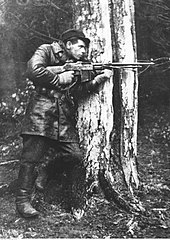
In addition to the Home Army, there was an underground ultra-nationalist[17] resistance force called Narodowe Siły Zbrojne (NSZ or "National Armed Forces"), with a fiercely anti-communist stance. It participated in fighting German units, winning many skirmishes. From 1943 onwards, some units took part in battling the Gwardia Ludowa and the Polish People's Army PAL, both communist resistance movement. From 1944, the advancing Red Army was also seen as a foreign occupation force, prompting skirmishes with the Soviets as well as Soviet-backed partisans. In the later part of the war, when Soviet partisans started attacking Polish partisans, sympathizers and civilians, all non-communist Polish formations were (to an increasing extent) becoming involved in actions against the Soviets.[21]
The Armia Ludowa, a Soviet proxy fighting force[22] was another resistance group that was unrelated to the Polish Government in Exile, allied instead to the Soviet Union. As of July, 1944 it incorporated a similar organization, the Gwardia Ludowa and the Polish People's Army PAL, and numbered about 6,000 soldiers (although estimates vary).[22]
There were separate resistance groups organized by Polish Jews:[17] the right-wing Żydowski Związek Walki ("Jewish Fighting Union") (ŻZW) and the more Soviet-leaning Żydowska Organizacja Bojowa ("Jewish Combat Organization") (ŻOB). These organisations cooperated little with each other and their relationship with the Polish resistance varied between occasional cooperation (mainly between ZZW and AK) to armed confrontations (mostly between ŻOB and NZS).
Other notable Polish resistance organizations included the Bataliony Chłopskie (BCh), a mostly peasant-based organization allied to the AK. At its height the BCh included 115,543 members (1944; with additional LSB and PKB-AK Guard, for the estimated total of 150,250 men, not confirmed).[23][better source needed]
Throughout the war the German state was forced to divert a substantial part of its military forces to keep control over Poland:





| Period | Wehrmacht | Police and SS
(German forces only) |
Total |
|---|---|---|---|
| October 1939 | 550,000 | 80,000 | 630,000 |
| April 1940 | 400,000 | 70,000 | 470,000 |
| June 1941 | 2,000,000
(invasion of the Soviet Union) |
50.000 | 2,050,000 |
| February 1942 | 300,000 | 50,000 | 350,000 |
| April 1943 | 450,000 | 60,000 | 510,000 |
| November 1943 | 550,000 | 70,000 | 620,000 |
| April 1944 | 500,000 | 70,000 | 570,000 |
| September 1944 | 1,000,000 | 80,000 | 1,080,000 |
| Action type | Action totals |
|---|---|
| Damaged locomotives | 6,930 |
| Delayed repairs to locomotives | 803 |
| Derailed transports | 732 |
| Transports set on fire | 443 |
| Damage to railway wagons | 19,058 |
| Blown up railway bridges | 38 |
| Disruptions to electricity supplies in the Warsaw grid | 638 |
| Army vehicles damaged or destroyed | 4,326 |
| Damaged aeroplanes | 28 |
| Fuel tanks destroyed | 1,167 |
| Fuel destroyed (in tonnes) | 4,674 |
| Blocked oil wells | 5 |
| Wagons of wood wool destroyed | 150 |
| Military stores burned down | 130 |
| Disruptions of production in factories | 7 |
| Built-in faults in parts for aircraft engines | 4,710 |
| Built-in faults into cannon muzzles | 203 |
| Built-in faults into artillery projectiles | 92,000 |
| Built-in faults into air traffic radio stations | 107 |
| Built-in faults into condensers | 70,000 |
| Built-in faults into (electro-industrial) lathes | 1,700 |
| Damage to important factory machinery | 2,872 |
| Various acts of sabotage performed | 25,145 |
| Planned assassinations of Germans | 5,733 |
Intelligence


Polish intelligence supplied valuable intelligence to the Allies; 48% of all reports received by the British secret services from continental Europe in between 1939 and 1945 came from Polish sources.[26] The total number of those reports is estimated at 80,000, and 85% of them were deemed high or better quality.[27] Despite Poland becoming occupied, the Polish intelligence network not only survived but grew rapidly, and near the end of the war had over 1,600 registered agents[26] (Another estimate gave about 3,500[citation needed]).
Western Allies had limited intelligence assets in Central and Eastern Europe, and extensive Polish intelligence network in place proved to be a major asset, even described as "the only allied intelligence assets on the Continent" following the French capitulation.[28][29][30] According to Marek Ney-Krwawicz, for the Western Allies, the intelligence provided by the Home Army was considered to be the best source of information on the Eastern Front.[31]
In a period of more than six and a half years, from late December 1932 to the outbreak of World War II, three mathematician-cryptologists (Marian Rejewski, Henryk Zygalski and Jerzy Różycki) at the Polish General Staff's Cipher Bureau in Warsaw had developed a number of techniques and devices— including the "grill" method, Różycki's "clock", Rejewski's "cyclometer" and "card catalog", Zygalski's "perforated sheets", and Rejewski's "cryptologic bomb" (in Polish, "bomba", precursor to the later British "Bombe", named after its Polish predecessor)— to facilitate decryption of messages produced on the German "Enigma" cipher machine. Just five weeks before the outbreak of World War II, on July 25, 1939, near Pyry in the Kabaty Woods south of Warsaw, Poland disclosed her achievements to France and the United Kingdom, which had, up to that time, failed in all their own efforts to crack the German military Enigma cipher.[32] Had Poland not shared her Enigma-decryption results at Pyry, the United Kingdom might have been unable to read Enigma ciphers.[33] In the event, intelligence gained from this source, codenamed Ultra, was extremely valuable to the Allied prosecution of the war. While ULTRA's precise influence on its course remains a subject of debate, ULTRA undoubtedly altered the course of the war.[34]
As early as 1940, Polish agents (including Witold Pilecki) penetrated German concentration camps, including Auschwitz, and informed the world about Nazi atrocities. Jan Karski is another important Polish resistance fighter who reported to the Polish government in exile and the Western Allies on the situation in German-occupied Poland, especially the destruction of the Warsaw Ghetto, and the secretive German-Nazi extermination camps.[35][36]

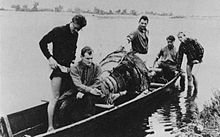
Polish Home Army (Armia Krajowa, AK) intelligence was vital to locating and destroying (18 August 1943) the German rocket facility at Peenemünde and to gathering information about Germany's V-1 flying bomb and V-2 rocket. The Home Army delivered to the United Kingdom key V-2 parts after a rocket, fired on 30 May 1944, crashed near a German test facility at Sarnaki on the Bug River and was recovered by the Home Army. On the night of 25–26 July 1944 the crucial parts were flown from occupied Poland to the United Kingdom in an RAF plane, along with detailed drawings of parts too large to fit in the plane (see Home Army and V1 and V2). Analysis of the German rocket became vital to improving Allied anti-V-2 defenses (see Operation Most III).[37]
Operations of the II Bureau, the intelligence service of the Polish government in exile, extended beyond Poland and even beyond Europe. Polish agents provided reports on German war production, morale and troop movements, including information on German submarine operations.[30][38] The II Bureau is reported to have had two agents in the upper levels of the German high command.[30] Polish intelligence monitored the French fleet at Toulon.[30] Mieczysław Zygfryd Słowikowski has been described as "the only allied agent with a network in North Africa".[30] In July 1941 Mieczysław Słowikowski (codenamed "Rygor"—Polish for "Rigor") set up "Agency Africa", one of World War II's most successful intelligence organizations.[39] His Polish allies in these endeavors included Lt. Col. Gwido Langer and Major Maksymilian Ciężki (prewar heads, respectively, of Poland's Biuro Szyfrów, Cipher Bureau, and of its German section, B.S.-4, which broke Germany's Enigma ciphers).[32] The information gathered by the Agency was used by the Americans and British in planning the amphibious November 1942 Operation Torch[40][better source needed] landings in North Africa. These were the first large-scale Allied landings of the war, and their success in turn paved the way for the Allies' Italian campaign.[citation needed]
Some Poles also served in other Allied intelligence services, including the celebrated Krystyna Skarbek ("Christine Granville") in the United Kingdom's Special Operations Executive.[41]
The researchers who produced the first Polish-British in-depth monograph on Home Army intelligence (Intelligence Co-operation Between Poland and Great Britain During World War II: Report of the Anglo-Polish Historical Committee of 2005) and who described contributions of Polish intelligence to Allied victory as "disproportionally large"[42] have also argued that "the work performed by Home Army intelligence undoubtedly supported the Allied armed effort much more effectively than subversive and guerilla activities."[43]
Polish Forces (West)
Army
| Deserters from the German Wehrmacht | 90,000 |
| Evacuees from the USSR | 83,000 |
| Evacuees from France in 1940 | 35,000 |
| Liberated POWs | 21,750 |
| Escapees from occupied Europe | 14,210 |
| Recruits in liberated France | 7,000 |
| Polonia from Argentina, Brazil and Canada | 2,290 |
| Polonia from the United Kingdom | 1,780 |
| Total | 254,830 |
| By July 1945, when recruitment was halted, some 26,830 Polish soldiers were declared KIA or MIA or had died of wounds. After that date, an additional 21,000 former Polish POWs were recruited. | |
After the country's defeat in the 1939 campaign, the Polish government in exile quickly organized in France a new army of about 75,000 men.[45] In 1940 a Polish Highland Brigade took part in the Battle of Narvik (Norway), and two Polish divisions (First Grenadier Division, and Second Infantry Fusiliers Division) took part in the defense of France, while a Polish motorized brigade and two infantry divisions were in process of forming.[46] A Polish Independent Carpathian Brigade was formed in French Mandate Syria, to which many Polish troops had escaped from Romania.[47] The Polish Air Force in France had 86 aircraft with one and a half of the squadrons fully operational, and the remaining two and a half in various stages of training.[47]
By the fall of France, numerous Polish personnel had died in the fighting (some 6,000) or had been interned in Switzerland (some 13,000). Nevertheless, about 19,000 Polish—about 25% of which were aircrew—were evacuated from France, most alongside other troops transported from western France to the United Kingdom.[45] In 1941, following an agreement between the Polish government in exile and Joseph Stalin, the Soviets released Polish citizens, from whom a 75,000-strong army was formed in the USSR under General Władysław Anders. Without any support from the Soviets to train, equip and maintain this army, the Polish government in exile followed Anders' advice for a transfer of some 80,000 (and about 20,000 civilians), in March and August 1942, across the Caspian Sea to Iran permitting Soviet divisions in occupation there to be released for action.[48] In the Middle East, this "Anders' Army" joined the British Eighth Army, where it formed Polish II Corps.[49]

The Polish Armed Forces in the West fought under British command and numbered 195,000 in March 1944 and 165,000 at the end of that year, including about 20,000 personnel in the Polish Air Force and 3,000 in the Polish Navy. At the end of World War II, the Polish Armed Forces in the west numbered 195,000 and by July 1945 had increased to 228,000, most of the newcomers being released prisoners of war and ex-labor camp inmates.
Air force
The Polish Air Force first fought in the 1939 Invasion of Poland. Significantly outnumbered and with its fighters outmatched by more advanced German fighters, remained active up to the second week of the campaign, inflicting significant damage on the Luftwaffe.[50] The Luftwaffe lost, to all operational causes, 285 aircraft, with 279 more damaged, while the Poles lost 333 aircraft.[51]
After the fall of Poland many Polish pilots escaped via Hungary to France. The Polish Air Force fought in the Battle of France as one fighter squadron GC 1/145, several small units detached to French squadrons, and numerous flights of industry defence (in total, 133 pilots, who achieved 53–57 victories for a loss of 8 men in combat, what was 7.93% of allied victories).[52]
Later, Polish pilots fought in the Battle of Britain, where the Polish 303 Fighter Squadron claimed the highest number of kills of any Allied squadron. From the very beginning of the war, the Royal Air Force (RAF) had welcomed foreign pilots to supplement the dwindling pool of British pilots. On 11 June 1940, the Polish Government in Exile signed an agreement with the British Government to form a Polish Army and Polish Air Force in the United Kingdom. The first two (of an eventual ten) Polish fighter squadrons went into action in August 1940. Four Polish squadrons eventually took part in the Battle of Britain (300 and 301 Bomber Squadrons; 302 and 303 Fighter Squadrons), with 89 Polish pilots. Together with more than 50 Poles fighting in British squadrons, a total of 145 Polish pilots defended British skies. Polish pilots were among the most experienced in the battle, most of them having already fought in the 1939 September Campaign in Poland and the 1940 Battle of France. Additionally, prewar Poland had set a very high standard of pilot training. The 303 Squadron, named after the Polish–American hero, General Tadeusz Kościuszko, claimed the highest number of kills (126) of all fighter squadrons engaged in the Battle of Britain, even though it only joined the combat on August 30, 1940[53] These Polish pilots, constituting 5% of the pilots active in the Battle of Britain, were responsible for 12% of total victories in the Battle.
The Polish Air Force also fought in 1943 in Tunisia—the Polish Fighting Team (nicknamed "Skalski's Circus")—and in raids on Germany (1940–45). In the second half of 1941 and early 1942, Polish bomber squadrons formed a sixth of the forces available to RAF Bomber Command but later they suffered heavy losses, with little replenishment possibilities. Polish aircrew losses serving with Bomber Command from 1940 to 1945 were 929 killed. Ultimately eight Polish fighter squadrons were formed within the RAF and had claimed 629 Axis aircraft destroyed by May 1945. By the end of the war, about 19,400 Poles were serving in the RAF.[54]
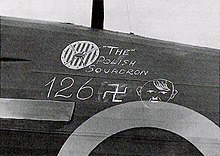

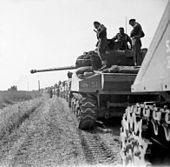
Polish squadrons in the United Kingdom:
- No. 300 "Masovia" Polish Bomber Squadron (Ziemi Mazowieckiej)
- No. 301 "Pomerania" Polish Bomber Squadron (Ziemi Pomorskiej)
- No. 302 "City of Poznań" Polish Fighter Squadron (Poznański)
- No. 303 "Kościuszko" Polish Fighter Squadron (Warszawski imienia Tadeusza Kościuszki)
- No. 304 "Silesia" Polish Bomber Squadron (Ziemi Śląskiej imienia Ksiecia Józefa Poniatowskiego)
- No. 305 "Greater Poland" Polish Bomber Squadron (Ziemi Wielkopolskiej imienia Marszałka Józefa Piłsudskiego)
- No. 306 "City of Toruń" Polish Fighter Squadron (Toruński)
- No. 307 "City of Lwów" Polish Fighter Squadron (Lwowskich Puchaczy)
- No. 308 "City of Kraków" Polish Fighter Squadron (Krakowski)
- No. 309 "Czerwien" Polish Fighter-Reconnaissance Squadron (Ziemi Czerwieńskiej)
- No. 315 "City of Dęblin" Polish Fighter Squadron (Dębliński)
- No. 316 "City of Warsaw" Polish Fighter Squadron (Warszawski)
- No. 317 "City of Wilno" Polish Fighter Squadron (Wileński)
- No. 318 "City of Gdansk" Polish Fighter-Reconnaissance Squadron (Gdański)
- No. 663 Polish Artillery Observation Squadron – flying in support of Polish artillery units
- Polish Fighting Team (Skalski's Circus) – attached to No. 145 Squadron RAF
- No. 138 Special Duty Squadron Polish Flight "C"
- No. 1586 Polish Special Duty Flight
| 1940 | 1941 | 1942 | 1943 | 1944 | 1945 | total | |
|---|---|---|---|---|---|---|---|
| destroyed | 266 1/6 | 202 | 90 | 114¾ | 103 | 38½ | 769 5/12 |
| probable | 38 | 52 | 36 | 42 | 10 | 2 | 177 |
| damaged | 43⅔ + 3/5 | 60½ | 43 | 66 | 27 | 18 | 252 1/6 |
Navy
Just on the eve of war, three destroyers—representing most of the major Polish Navy ships—had been sent for safety to the United Kingdom (Operation Peking). There they fought alongside the Royal Navy. At various stages of the war, the Polish Navy comprised two cruisers and a large number of smaller ships. The Polish navy was given a number of British ships and submarines which would otherwise have been unused due to the lack of trained British crews. The Polish Navy fought with great distinction alongside the other Allied navies in many important and successful operations, including those conducted against the German battleship Bismarck.[57] In the war the Polish Navy operated a total of 27 ships: 2 cruisers, 9 destroyers, 5 submarines and 11 torpedo boats. They sailed a total of 1.2 million nautical miles, escorted 787 convoys, conducted 1,162 patrols and combat operations, sank 12 enemy ships (including 5 submarines) and 41 merchant vessels, damaged 24 more (including 8 submarines) and shot down 20 aircraft. 450 seamen out of the over 4,000 who served with the Navy lost their lives in action.[58][59]

- Cruisers:
- ORP Dragon Dragoon – (British Danae class)
- ORP Conrad (British Danae class)
- Destroyers:
- ORP Wicher – Gale (Wicher class) sunk September 1939
- ORP Burza – Storm (Wicher class)
- ORP Grom – Thunder (Grom class) sunk 1940
- ORP Błyskawica – Lightning (Grom class)
- ORP Garland (British G class)
- ORP Orkan – Windstorm (British M-class destroyer Myrmidion) sunk 1943
- ORP Ouragan, sometimes called Huragan– Hurricane (French Bourrasque class)
- ORP Piorun – Thunderbolt (British N class)
- Escort destroyers:
- ORP Krakowiak – Cracovian (British Hunt class) 1941–1946
- ORP Kujawiak – Kujawian (British Hunt class)
- ORP Ślązak – Silesian (British Hunt class)
- Submarines:
- ORP Orzeł – Eagle (Orzeł class) lost 1940
- ORP Sęp – Vulture (Orzeł class) interned Sweden
- ORP Jastrząb – Hawk (USN S class)
- ORP Wilk – Wolf (Wilk class) to reserve 1942
- ORP Ryś – Lynx (Wilk class) interned Sweden
- ORP Żbik – Wildcat (Wilk class) interned Sweden
- ORP Dzik – Boar (British U class) 1942–1946
- ORP Sokół – Falcon (British U class) 1941–1945
- Heavy minelayers:
- ORP Gryf – Griffin sunk 1939
- Light minelayers ("ptaszki"– "Birds"):
- ORP Jaskółka – Swallow, sunk 1939
- ORP Mewa – Seagull
- ORP Rybitwa – Tern
- ORP Czajka – Lapwing
- ORP Żuraw – Crane
- ORP Czapla – Heron
- Polish River Fleet
This does not include a number of minor ships, transports, merchant-marine auxiliary vessels, and patrol boats. Polish Merchant Navy contributed about 137,000 BRT to Allied shipping; losing 18 ships (with capacity of 76,000 BRT) and over 200 sailors in the war.[60]
Polish Forces (East)

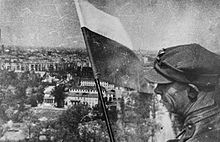
After the Polish government-in-exile organized the Anders Army in 1941 in the Soviet Union in the aftermath of the Operation Barbarossa and evacuated it to the West, Polish communists sought to create a new army, under communist control, out of the many ethnic Poles that remained in the Soviet Union. These were primarily citizens of the prewar Second Polish Republic that had been deported and often imprisoned by the Soviets following the Soviet annexation of Poland's eastern territories, as per the Molotov-Ribbentrop Pact. The Soviet Union created the Union of Polish Patriots (ZPP) in 1943, a communist Polish organization intended to represent the interest of Poles on Soviet soil and organize this new army.[61][62] The relocated Poles, along with numbers of Byelorussians, Ukrainians, and Polish Jews, were organized into a division, the nucleus of a force known as the Polish People's Army (Ludowe Wojsko Polskie, LWP) but colloquially known as the Berling Army after its first commander, Zygmunt Berling. The division made its combat debut in October 1943 at the Battle of Lenino. Afterwards, it was rapidly expanded into the 1st Polish Corps, which in turn grew by 1944 into the 1st Polish Army. In 1945, 2nd Polish Army was added to the LWP. By the end of the war, the LWP numbered about 200,000 front-line soldiers.[62] The Polish communist guerilla force, the Armia Ludowa, was integrated with the Polish People's Army in January 1944.
The Polish First Army was integrated in the 1st Belorussian Front with which it entered Poland from Soviet territory in 1944. In the 1944 Warsaw Uprising it liberated the suburb of Praga, but otherwise sat out most of the battle, aside from a series of unsuccessful crossings of the Vistula in mid-September. It took part in battles for Bydgoszcz (Bromberg), Kolobrzeg (Kolberg), Gdańsk (Danzig) and Gdynia, losing about 17,500 killed in action over the course of the war.[62] In April–May 1945 the 1st Army fought in the final capture of Berlin. The Polish Second Army fought as part of the Soviet 1st Ukrainian Front and took part in the Prague Offensive. In the final operations of the war the casualties of the two armies of the LWP amounted to about 67,000.
Poles in the German Armed Forces
Hundreds of thousands of former Polish citizens, particularly residents of parts of Poland annexed to Germany, were conscripted into the German Armed Forces. Also, a number of former Polish citizens, especially members of the prewar German minority in Poland (see Volksliste), volunteered for service in the German Armed Forces.[63] These were mostly members of the German minority in Poland who were considered by the Nazi authorities to be ethnically German (Volksdeutsche). In 1939 in the Invasion of Poland they created the paramilitary organisation Volksdeutscher Selbstschutz, and actively supported German forces in occupied Poland.[64]
On the Western Front, German military personnel of Polish ethnicity, held in prisoner-of-war camps, became a substantial source of manpower for the Polish Armed Forces in the West. Nearly 90,000 former German military personnel were eventually recruited into the Polish Armed Forces in the West. By Victory Day (9 May) in 1945, a third of Polish service members in the West were former members of the German Armed Forces.[63]
Battles
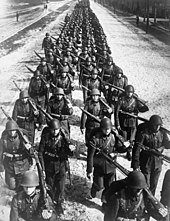

Major battles and campaigns in which Polish regular forces took part:
